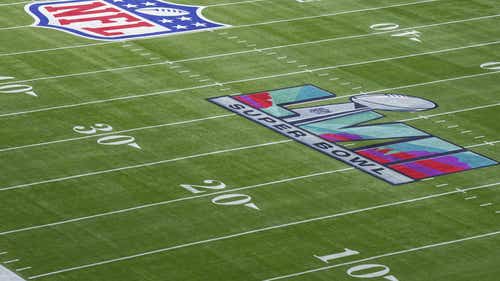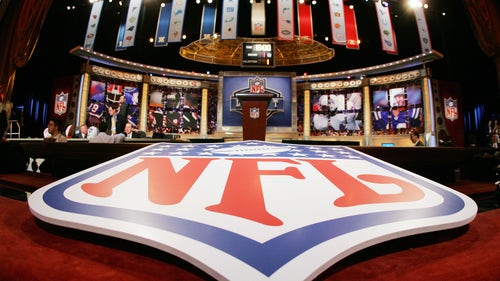
Kurt Warner is teaching, learning as a high school offensive coordinator

SCOTTSDALE, Ariz. — It’s 5:30 a.m., and if you stand in just the right spot on the home turf at Desert Mountain High, you can watch the moon slowly fade from view between towering yellow goalposts. The sky is a stunning midnight blue as the football team convenes for practice on the last Wednesday of September, and former Super Bowl MVP Kurt Warner is doing what high school offensive coordinators do: instructing teenage quarterbacks to throw the football with their bodies, not their arms.
“Let’s see how quickly you can get it out there,” Warner tells senior starter Austin Nuessle and sophomore Kedon Slovis. “Speed up your drop. The quicker you are, the less you have to put on it. You’re trying to speed it up by throwing it really hard. You have to speed up the feet.”

The footballs start being delivered on quick slants and five-yard outs with the right kind of pop, the kind that starts with the feet and surges through the hips and launches with a flick of the elbow and wrist.
“That hip balance has to be in every throw you make,” Warner says with calm insistence. “You lose that and it’s all upper body; no telling where it’s going.”
The Desert Mountain varsity team has yet to win a game to this point, despite having an offensive coordinator who has played in three Super Bowls and won two NFL MVP awards, and a receiver—Warner’s son, Kade—who is Arizona’s new record holder for receptions in a high school career. The Wolves have struggled in their move from 5A, where they won six games and went to the playoffs a season ago in Warner’s first year as coordinator, to 6A, losing all five of their non-league games before last Friday’s league opener versus Pinnacle High.

But the benefit of having an actual NFL superstar as coach goes beyond wins and losses. When the team traveled to Carson City, Nev., for a kickoff weekend with three other schools to open the season, Warner, 45, spoke to players from all four teams about defining success. He told them winning is not all about the scoreboard. He’d played in three Super Bowls, and in each of those games he’d walked to the bench with under three minutes left having just thrown a touchdown pass to either put his team ahead or tie the game. And yet he’d only won the one championship—Super Bowl XXXIV in the 1999 season, against the Titans.
“Too often we look at the final score and say, okay, this guy’s a winner or a loser,” Warner says. “Had I done nothing else in any of those games, I could’ve been a three-time winner. I look at it like, Did I give everything I can? And let the chips fall as they may.”

Warner’s talk that day was informed by what he figured could be a grim season for Desert Mountain. The offensive and defensive lines are typically outmatched by bigger and stronger kids, with an army of reserves on the opposing sideline. Yet for one night last week that didn’t seem to matter. On the last day of September, two days after the Wednesday morning practice in Scottsdale, the Wolves hosted 1-5 Pinnacle, and the sort of breaks that usually go against Desert Mountain started going the other way. Fumble after fumble wound up in the hands of the home team, and Desert Mountain was able to hold off Pinnacle long enough to force overtime. Two touchdowns later, Desert Mountain faced a key decision: Go for two—for the win—or kick the field goal and tie.
The Wolves coaches sent the offense back on the field.
* * *
Kade Warner has muscles in places his father never had. At 6'2", 205 pounds with tree trunk legs, he looks more like a versatile tight end than the most prolific receiver in Arizona prep history. Despite leading his team in receptions since he was a sophomore, he has yet to receive an FBS offer; he believes it has to do with his speed. “I think a lot of colleges don’t think I’m quick enough,” Kade says, “but I haven’t seen too many people catch up to me.”
Kade never played quarterback in tackle football. During one of his first Pop Warner seasons, on the first day of practice, coaches were giddy to have the son of the starting Arizona Cardinals quarterback on the team. Surely, he too played quarterback. “They have him try to throw passes right off the bat, and he threw the first three to the ground,” Kurt says. “And you could just see the look on their faces like, Are you serious? I don’t think Kade has ever wanted the pressure of being a quarterback and being my son, so he’s naturally gravitated to other positions.”

Coaches from Kade’s past teams have encouraged him to use his father’s name in emails to college coaches spelling out his credentials and providing a link to his Hudl.com highlight reel, but Kade declines. “I know when they get me on campus and see me in practice they’ll realize I don’t play like a kid with a famous dad, but still, in my letters I don’t put Kurt Warner’s son," Kade says. "I want to make a name for myself without putting my dad’s name out there.”
Kade gets a kick out of watching his friends work with his dad, whose career in the NFL he says he didn’t fully understand or appreciate. “I was too young to really understand how special it was,” Kade says, “But now you see him drop back in practice and be falling away and he throws a perfect dime and our quarterbacks are like ummmm.”
* * *
As practice wraps up on Wednesday around 7 a.m, Warner steps into a black SUV and drives to the temporary home his family is renting while floors are replaced at their Scottsdale mansion. Warner is greeted by a novice’s rendition of Beethoven’s Ode to Joy on cello; his daughter, 10-year-old Sierra, is practicing the instrument before school in the backyard. Kurt corrals two of his seven children, including seventh-grader Elijah, the only quarterback in the family, and begins the drive back to Desert Mountain.
Elijah returned to flag football two years ago after a season in tackle that didn’t suit him. When Elijah was in fourth grade, Kurt and his wife, Brenda, faced a decision that scores of parents across the country grapple with each summer: How soon is too soon for tackle football?
“What I came to realize in tackle at that age is that you can’t teach anybody football,” Warner says after his son exits the car. “You’re not teaching them how to read coverage; it’s simply run for your life. And if your team is physically undermanned, you’re just gonna get beat up. You have all the issues with head injuries, and as a parent you take the approach of, Why do I need my kid to get hit before he needs to?

“At one point he looked up at me and he was like, This isn’t what I signed up for. This isn’t what I thought football was. And I thought he was losing his love for the sport, because you get the ball, you run for your life and get tackled by five guys, now get up and do it again. And I just felt that’s not the right environment to learn how to play the game. So I pulled him back into flag, which is 95% pass, so he gets a chance to read plays and coverages. Now I’m just debating whether it’s best to get him a year of tackle before high school, or do what we’re doing, and he’ll just have to learn to take a hit.”
Warner, who retired soon after suffering a concussion in a January 2010 playoff game against the Saints (a play that would later come under scrutiny in the Bountygate investigation), says he values the character-building qualities of football over the potential risks. He says his retirement had nothing to do with the game's physical aspect, as he’s suffered no long-term consequences.
“There is definitely the understanding that it's an issue,” Warner says. “As a parent you put on a different hat. It’s so much about communication and making sure your kids are ready and able to communicate with you about when they are feeling injured and whether or not their having fun.”

Warner says he did have concerns about Kade suffering a possible concussion in a game earlier this year, and despite his son’s passing the sideline medical protocol, Kurt made the decision to sit him for the entire second half of a close game. “It was just a parent’s feeling that something’s not quite right here. You feel fine, and you pass all the tests, but you know you’re just not functioning properly. I wouldn’t let any kid out here without feeling 100 percent that he was 100 percent.
“I understand what this game taught me, and the person it made me, and I want my kids to enjoy that. Too many parents think about their 10-year-old kid playing in the NFL. Kids should be in sports for the team atmosphere, how it creates character, the activity. The focus is not getting these kids scholarships. It’s about building character and seeing where it takes them from there.”
* * *
The mental aspect of the game, specifically the ability to anticipate and outmaneuver the opponent’s thinking, is what makes Warner miss the NFL and attracted him to coaching—and it’s also what makes this season particularly frustrating. In practice Kurt is patient, rarely raises his voice and never criticizes, but the transition from working with professionals as recently as 2009, the year he retired from the Cardinals, to coaching teenagers has been frustrating at times. He’s tailored the offense to his team’s shortcomings, employing half-field reads with plenty of screen passes that take advantage of a group of athletic receivers and relieve stress on the offensive line.
“If I went out there and expected from them what I see in an NFL practice, then that’s on me," Warner says. "I have to have realistic expectations. I have to think, how can I make it easier on them? If a guy’s open I’m thinking to myself, we’ve gotta hit him. But I never want to set my expectations too high because that leads to my frustration and then the players’ frustration, because they’re doing the best they can.”

The biggest challenge, Warner says, is the lack of available practice time. The school schedules of the senior students and the work schedules of some of the coaches make afternoon sessions impracticable. Two hours a day five days a week, beginning before sunrise, doesn’t allow for multiple wholesale adjustments to existing plays based on an upcoming opponent’s tendencies. So Kurt builds wrinkles into plays requiring only that Austin, Kade and a handful of teammates put in the extra time in the film room.
That room, as it were, is an office in Warner’s Scottsdale mansion, a seven-bedroom, 10-bathroom paradise with a football field in the back and an outdoor pool that snakes around the property. The house is also where Warner films his weekly analyst’s hits for the NFL Network. Weaving through a maze of displaced couches and rolled-up rugs, Warner sits down for an afternoon taping with his rescue dog, Stella, resting at his side. In the background behind Kurt as he goes through the league’s latest news with host Andrew Siciliano is a dresser decorated with mementos from his career, including a small replica Super Bowl trophy, his NFL Walter Payton Man of the Year Award and helmets from his days with the Rams and Giants. The centerpiece is a large canvas of abstract art painted by Brenda 20 years ago, in the weeks after her parents were killed in a tornado in Mountain View, Ark.
“I was never creative before that," Brenda says, "I didn’t really know what I was doing at the time, and I’d never painted anything before. I just felt like I needed to. Now I see it, and I see tornado and water, and I understand what I was going through.”

Today the Warner home is decorated top to bottom with Brenda’s artwork. Paintings of animals adorn the garage doors, and she spends much of her time, outside charity work—the First Things First Foundation and Treasure House, which offers community living for persons with development disabilities—and ferrying her children around town, in a garage space that she converted into a metal-welding studio. One of her newest pieces, a woman with outstretched arms, bears a heart across the chest outlined with ruby-colored stones. “They were supposed to be boobs,” she says with a laugh, “but they ended up being a heart, which is probably more appropriate, right?”
At 1:30 Nuessle and his backup, sophomore Kedon Slovis, ride from the high school to Warner’s gated home in Nuessle’s well-travelled Honda CRV. Nuessle says he pinches himself daily to make sure he’s not dreaming; earlier this week he and Warner had lunch together at a local sports bar and watched NFL film on Warner’s laptop, just the two of them. Now he’s headed to Warner’s home to install Friday’s game plan.
Nuessle looks to Slovis in the passenger seat: “We must be the luckiest kids in America.”

The prospect of working daily with Warner motivates Nuessle and drives him towards pursuing college football. “I’m just sad it’s going to end soon,” says Neussle, who is averaging 334.3 passing yards per game and has thrown 19 touchdown passes. The big project today, after reviewing some Kansas City Chiefs game film, Pinnacle’s defensive tendencies and Wednesday’s Desert Mountain practice film, is “Smasher.” It’s a variation off of a regular passing play, Smash, in which the inside receiver, usually Kade, runs a corner, and the outside receiver runs a hitch. Smash is one of about 30 passing concepts in the Desert Mountain offense, compared to just eight running plays. Pinnacle will be prepared to cover both routes, but they might just be baited into jumping the corner. If Kade can adjust his corner into a sort of abbreviated corner-post route, it could be a game-changer.
“We’re going out to throw the hitch, and he’s going to hint to the corner and go to the post,” Kurt says. “At some point that corner, as we’ve seen, is going to settle, so now it’s you one-on-one with the safety. If he leans at all in that direction you put your foot in the ground and go.”
Kade understands, but Kurt keeps explaining the play for everyone’s benefit. As Nuessle nods, Kade illuminates his teammate’s earlobe with his father’s laser pointer, then focuses the pointer at the back of his father’s head. Kurt can sense the attention-defecit generation growing impatient, and he remembers that Brenda needs help moving a table in the dining room. They emerge from the office after two hours, to Brenda’s delight.
“They’re good boys,” she says as they circle around the massive tabletop. “They like helping me with this stuff and showing how strong they are.”
* * *
Smasher works to perfection. Halfway through the second quarter, after Pinnacle had been primed with several Smash throws to the hitch route, Warner dials up the variation and Kade rises above the safety, snares the pass and takes it all the way for a 67-yard touchdown to put the Wolves up 13-3. Later, in the second half, it’s announced that Kade has surpassed former Desert Mountain receiver Mark Andrews’s 207 career receptions to take the lead in the record books for 11-man football in Arizona. As Miley Cyrus' “Wrecking Ball” plays over the loudspeakers, the Warner clan, led by Brenda, wave giant posters of Kade’s face from the top row.

On Desert Mountain’s final offensive possession, Kade takes a Nuessle screen pass around the right corner for a six-yard touchdown to go up 28-20 with 2:02 left. In response, Pinnacle sophomore Spencer Rattler leads a drive the length of the field, facing little pass rush and forcing overtime with a touchdown pass to hulking senior tight end Dalton Cash. On the first overtime possession, Rattler connects with sophomore Hayden Hatten for the go-ahead touchdown; Desert Mountain then answers with a Nuessle touchdown pass to Joshua Walker. Now the Wolves coaches have a decision to make. An extra point, no guarantee after a missed field goal earlier in the game, would force a tie and send it to double overtime. A two-point conversion gives Desert Mountain its first win in 2016.
Head coach David Sedmak consults with Warner about going for two, and Warner says he has a good play for that scenario. Sedmak says, “Let’s do it.”

With the game on the line, Nuessle takes a shotgun snap, sprints to his right, hops off his back foot and throws into a sea of arms, with Kade Warner at the center. The ball falls harmlessly to the turf.
“It played out exactly like I thought it would, but we didn’t execute it,” Warner says. “But you can’t say that. Truth is, I didn’t call the right play if our guys didn’t execute. I think that’s the burden you put on yourself at this level. You can’t put the burden on the kids. You have to call the right play, and then the only way it’s relevant is if you make sure the kids can execute the play. I put a lot of pressure on myself, and it’s more time consuming and difficult than I thought it would be.”
The quest for Win No. 1: It’s the grind of Kurt Warner’s 45th year, shared with his son, for one final season of high school football. Kurt doesn’t know if the pursuit to win at Desert Mountain will last beyond this season. He’s a busy man, and he’ll want to spend weekends watching his son play college football, wherever he ends up.
Still, the lessons imparted at 5:30 a.m. require, above all things, the right teacher.
“You spend a lot of time with these kids," Warner says. "I feel obligated to help them and give them the same opportunity. I anticipate that I will.”
With contributing reporting by Andrew Milke in Scottsdale.

This article originally appeared on











